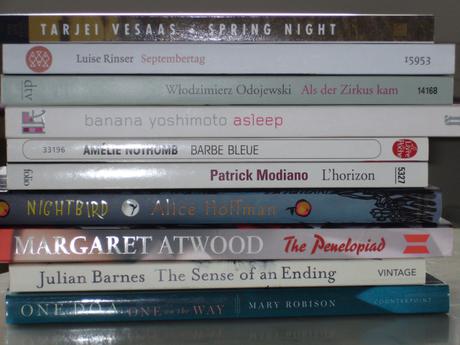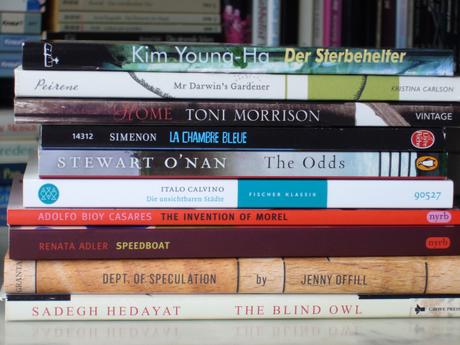
Like so many others, I’ve decided to do something about those huge piles of unread books and not buy so many new ones anymore. Quite a few of the bloggers I know have joined Eva Stalker’s #TBR20 project. The idea is to pick 20 books from your piles and not buy any new books before you read those.
A similar initiative is Cathy’s 20 Books of Summer. Both sound great, but I felt like giving them a twist and that’s why I’ll start my own project called 20 under 200. I’ve chosen 20 books from my piles, which are all under 200 pages. Ideally, I won’t buy any more books until I’ve read those. I will however allow myself to read other, longer books from the piles or exchange some that are on the photos against other novels under 200 pages.

Interestingly, the pile is very diverse, although I didn’t plan that at all. I think I managed to find books from 14 different countries: Japan, Korea, US, UK, Canada, France, Italy. Belgium, Iran, Germany, Poland, Norway, Finland, Argentine.
I was not surprised to see how many books under 200 pages I own. I could easily have added another 20 or 40. I’ve always had a preference for shorter novels.
On to the books:
Tarjei Vesaas – Spring Night (1964, Norway). Vesaas is a Norwegian author whose books won many prizes. He was a candidate for the Nobel Prize in 1964, 1968, and 1969. The book tells the story of one nigt in the life of Sissel and her brother Olaf. They are alone on their parents farm when a strange family whose car has broken down, descends on them.
Luise Rinser – Septembertag (1967, Germany). Luise Rinser is very famous and highly acclaimed in Germany, but not many of her books have been translated. Septembertag – A Day in September – is creative nonfiction. It’s the account of one day. At the time she was living in Rome. I wish more of her books had been translated. I’ve never read anything by her that wasn’t profound and poetic.
Wlodzimierz Odojewski When the Circus Arrived (2000, Poland) Polish author Wlodzimierz Odojewski’s book is another one that hasn’t been translated. The book contains two novellas. I’ve read an excerpt of one and was stunned. The way history is blended into the narrative was masterful.
Banana Yoshimoto – Asleep (1992, Japan) The book contains two novellas. Japanese author Banana Yoshimoto is one of my favorite writers, so I’m looking forward to return to her. In the blurb the stories are called “nostalgic, exquisitely sad, and delicate like gossamer”. Sounds promising.
Amélie Nothomb – Barbe Bleu (2012, Belgium) Amélie Nothomb is a Belgian writer, writing in French. She was born in Kobe and spent her first years in Japan. I’ve only read one of Nothomb’s novels and wasn’t so keen on it. I found it a bit cold and aseptic. But when I saw this book I had to get it because I’m fascinated by Blue Beard. Many authors, like Margaret Atwood, have been inspired by Blue Beard. I’m very curious to see what she made of it. I’m not sure this has been translated but usually all of her books are.
Patrick Modiano – L’horizon – Horizon (2010, France) This is only one of a few Modiano novels I have on my piles. He’s another author whose every book I used to read until I needed a pause. As much as I appreciate and love him, he can be a bit repetitive at times. But it’s time to get back to him. Like in most of his novels, he blends history and memory in L’horizon. His characters are always looking for lost time. I was so glad when I discovered he’d won the Nobel Prize.
Alice Hoffman – Nightbird (2015, US) Alice Hoffman’s latest novel is a YA novel. I’ve only read her books for adults so far. This is the story of a family secret. “A gorgeously bewitching tale of magic love and stretching your wings,” says the blurb.
Margaret Atwood – The Penelopiad (2005, Canada) I’ve had this for so many years, it’s about time I read it. The retelling of the story of Penelope, Odysseus’ wife, in form of a chorus of voices. It’s a technique I find highly fascinating.
Julian Barnes – The Sense of an Ending (2011, UK) I’m late for this one. I think it would be easier to name the bloggers who haven’t read it than those who have. I’m particularly interested in the ending of the novel because it has generated such a controversy.
Mary Robison – One D.O.A. One on the Way ( 2009, US) The story is set in New Orleans and told in vignettes. Mary Robison is famous for being unpredictable. I’ve only read her short stories and was impressed. I’m sure this will be just as amazing.
Kim Young-Ha – I Have the Right to Destroy Myself (2011 ?, Korea) This book is said to blend art and reality. Critics call Korean writer Young-Ha urban and edgy. Many of his novels have been translated into English. I Have the Right to Destroy Myself tells, among other things, the story of a love triangle.
Kristina Carlson – Mr Darwin’s Gardener (2009, Finland) Finnish author Kristina Carlson’s novel is a historical novel, set in Kent in 1870 and tells the story of Darwin’s gardener, Thomas Davies, a grief-stricken widower who has lost his faith.
Toni Morrison – Home (2012, US) I have read two of Morrison’s books so far and while I liked and admired Beloved I didn’t get along with Jazz. Home is her latest and, according to the reviews I read, her most readable. The story begins with a letter from a woman the protagonist has never met. “Come fast. She be dead if you tarry”. Sounds intriguing. I liked the idea that it explores the meaning of “home”. I often wonder myself.
Simenon – La Chambre Bleue – The Blue Room (1963, Belgium) This is one of Simenon’s romans durs – not one of his Maigret novels. It says on the cover: “Simenon’s gripping novel about lives transformed by deceit and the destructive power of lust.” It’s just been made into a movie.
Stewart O’Nan – The Odds (2012, US) Another favorite writer. It’s the story of a weekend. “A tender, bitter-sweet exploration of faith, forgiveness, and last chances.”
Italo Calvino – The Invisible Cities (1972, Italy) Italo Calvino was an Italian writer. The Invisible Cities is a series of short and very short fiction blending history, realism and fantasy. Calvino called the book “a love letter to the city”.
Adolfo Bioy Casares – The Invention of Morel (1964, Argentina) A fantastic exploration of virtual realities that Borges compared to The Turn of the Screw. An Argentinian classic.
Renata Adler – Speedboat (1971, US) Another experimental novel. The blurb says: It has been more than thirty-five years since Renata Adler’s Speedboat charged through the literary establishment, blasting genre walls and pointing the way for a newly liberated way of writing. This unclassifiable work is simultaneously novel, memoir, commonplace book, confession, and critique. It is the story of every man and woman cursed with too much consciousness and too little comprehension, and it is the story of Jen Fein, a journalist negotiating the fraught landscape of contemporary urban America. Her voice is cuttingly perceptive, darkly funny, and always fiercely intelligent as she breaks narrative convention to send dispatches back from the world as she finds it.
Jenny Offill – Dept. of Speculation (2014, US) This got much praise when it came out last year. It was called one of the most unusual books by many. “Written with the dazzling lucidity of poetry, Dept. of Speculation navigates the jagged edges of modern marriage to tell a story that is darkly funny, surprising and wise.” From the book: “They used to send each other letters. The return address was always the same: Dept. of Speculation.”
Sadegh Hedayat – The Blind Owl (1957, Iran) Possibly Iran’s most famous novel. Hedayat has been compared to Kafka and Chekhov. The novel has been forbidden for decades. I’m a bit wary because it’s said to be so depressing. It has even led to a wave of suicides. But it’s said to be as beautiful and poignant and the despair it describes is one most humans face at some point. “A haunting tale of loss and spiritual degradation.”
*****
I think those books will keep me busy this summer. What about you? Do you have summer reading plans?
If you like, you can join me in the 20 under 200 project and join, at the same time, Eva’s or Cathy’s projects.
